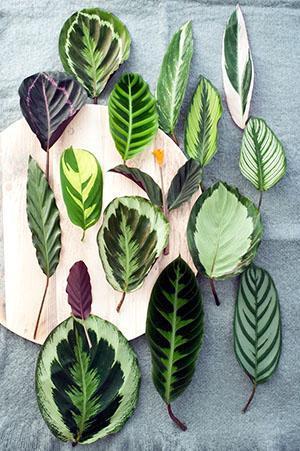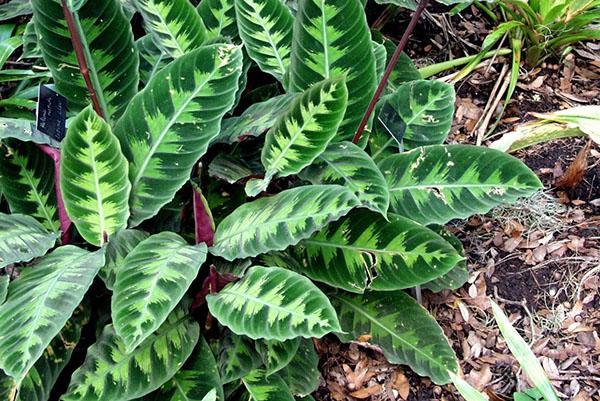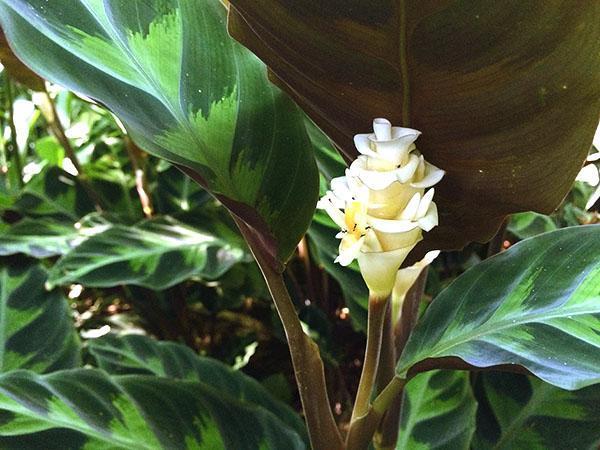Photo with a description of the types and varieties of indoor flower calathea
 Numerous photos of the calathea flower species amaze the imagination of flower growers not with fancy inflorescences, but with foliage with a unique coloring for each variety. The homeland of this genus of herbaceous variegated plants is the tropical zone of the South American continent.
Numerous photos of the calathea flower species amaze the imagination of flower growers not with fancy inflorescences, but with foliage with a unique coloring for each variety. The homeland of this genus of herbaceous variegated plants is the tropical zone of the South American continent.
Large, up to 70–80 cm high, calatheas are appreciated by lovers of indoor crops for the foliage of a rather simple oval or elliptical shape, with an original pattern on the leaf side of the plate and a thick burgundy color on the back. Each type of calathea, as in the photo, has its own unique ornament. In some varieties, leaf plates up to 20–40 cm long are noticeably corrugated.
Among the decorative-deciduous indoor crops, there are those that delight flower growers with spike-shaped inflorescences of different colors. Collecting a bright mix of kalata in your home collection, you can turn a room window sill into a semblance of a real tropical forest.
Calathea warscewiczii

 The inflorescence of Varshevich's calathea appears from the leaf axil, has a pitchfork of a spirally twisted white or pinkish bracts, from which small corollas that attract insects peep out. After the calathea flower withers, in the photo, young rosettes form on its petiole, which are used by flower growers to propagate an unusual indoor plant.
The inflorescence of Varshevich's calathea appears from the leaf axil, has a pitchfork of a spirally twisted white or pinkish bracts, from which small corollas that attract insects peep out. After the calathea flower withers, in the photo, young rosettes form on its petiole, which are used by flower growers to propagate an unusual indoor plant.
Saffron calathea (Calathea crocata)
 One of the most decorative types of cataleas grown at home. Not only does the variety have amazingly beautiful wavy foliage with a deep purple-green hue. A striking feature of this species is the large numerous inflorescences, an orange-yellow shade unusual for the calathea. It is thanks to the color close to that of saffron that Calathea Crocata got its second name.
One of the most decorative types of cataleas grown at home. Not only does the variety have amazingly beautiful wavy foliage with a deep purple-green hue. A striking feature of this species is the large numerous inflorescences, an orange-yellow shade unusual for the calathea. It is thanks to the color close to that of saffron that Calathea Crocata got its second name.
 Many growers know this graceful look as saffron calathea. Compared to closely related species, this plant is quite compact and does not take up much space even on a window sill. But the plant's disposition is not very flexible, it is possible to achieve flowering and stable growth of dark foliage only if all the requirements for caring for this guest from the distant tropics are met.
Many growers know this graceful look as saffron calathea. Compared to closely related species, this plant is quite compact and does not take up much space even on a window sill. But the plant's disposition is not very flexible, it is possible to achieve flowering and stable growth of dark foliage only if all the requirements for caring for this guest from the distant tropics are met.
The photo of a flower of this species clearly shows how bright orange inflorescences seem against the background of almost black foliage. Ornamental leafy culture responds well to feeding, does not tolerate direct sunlight and tolerates transplantation well, which gives it the opportunity to build up green mass.
Decorated calathea (Calathea ornata)
 Decorated calathea stands out from a number of related species with elongated ovate leaves with a pronounced central vein and a contrasting pattern of white stripes. At the disposal of florists today there are quite a few cultivars belonging to this beautiful species of calathea. But most often in the collections you can find the Sanderian calathea with dense broad-oval leaves of dark green okarska.
Decorated calathea stands out from a number of related species with elongated ovate leaves with a pronounced central vein and a contrasting pattern of white stripes. At the disposal of florists today there are quite a few cultivars belonging to this beautiful species of calathea. But most often in the collections you can find the Sanderian calathea with dense broad-oval leaves of dark green okarska.
Thin pink or white stripes extending in pairs from the central vein to the edges of the leaf plate give the plant decorativeness. The underside of the leaf is brownish or burgundy in color.
 At home, Calathea Sanderian does not grow above 50 cm, but in nature the crown can grow significantly and even reach two meters in height.
At home, Calathea Sanderian does not grow above 50 cm, but in nature the crown can grow significantly and even reach two meters in height.
Calathea striped (Calathea zebrina)
Although all types of calathea do not differ in a docile disposition and force the grower to constantly pay attention to themselves, this variety has a whimsical character.
 Calathea striped or zebrina is very sensitive to dry air; to grow it, you need very nutritious loose soil and attention to watering. In nature, the flower of this calathea species, as in the photo, grows rapidly and forms a powerful evergreen dwarf shrub up to a meter in height. With good care, calathea becomes just as tall in the house.
Calathea striped or zebrina is very sensitive to dry air; to grow it, you need very nutritious loose soil and attention to watering. In nature, the flower of this calathea species, as in the photo, grows rapidly and forms a powerful evergreen dwarf shrub up to a meter in height. With good care, calathea becomes just as tall in the house.
A special pride of striped calathea is its large leaves. The light, glossy 50-centimeter-long leaf plate is decorated with decorative strokes of dark green, the underside of the leaf is deep burgundy.
Calathea lancifolia
 The type of calathea shown in the photo belongs to the few, but very appreciated by flower growers, flowering plant varieties. At home, in the tropics of Brazil, calathea lancifolia lives in conditions of practically constant temperatures, high humidity and an abundance of nutrition. A lover of indoor plants will have to maintain the same atmosphere to admire the calathea flowers shown in the photo.
The type of calathea shown in the photo belongs to the few, but very appreciated by flower growers, flowering plant varieties. At home, in the tropics of Brazil, calathea lancifolia lives in conditions of practically constant temperatures, high humidity and an abundance of nutrition. A lover of indoor plants will have to maintain the same atmosphere to admire the calathea flowers shown in the photo.
Calathea lancifolia is a large houseplant that can grow up to 80 cm in height. The flowers are located on short peduncles located at the base of the leaf rosette. The corolla is white or slightly pinkish in color. The leaves are elongated, thin, light green in color with dark spots along the central vein. On the back side, the leaf plates of the calathea species of lansifolia have a reddish-purple color.
Calathea makoyana
The closest species to the previous plant is Calathea Makoya, originally from Brazil. The foliage of this variety is also covered with contrasting spots, but the leaf plates themselves are more rounded, and on their back side the pattern is completely repeated, only not in green, but in brownish-red tones.
Calathea rufibarba
 The pointed-elongated leaves of this calathea species, as in the photo, may seem ordinary in comparison with other species of this plant. The foliage has an even green color, which in some varieties extends to the back. And yet Calathea is very attractive due to the wavy shape of dense leaf plates that sit on long brownish-purple cuttings.
The pointed-elongated leaves of this calathea species, as in the photo, may seem ordinary in comparison with other species of this plant. The foliage has an even green color, which in some varieties extends to the back. And yet Calathea is very attractive due to the wavy shape of dense leaf plates that sit on long brownish-purple cuttings.
At home, the plant requires good nutrition and placement in diffused light. Subject to the conditions of maintenance, the florist can get small yellow, as in the photo, calathea flowers.
Calathea bachemiana
The leaves of this type of calathea are rather narrow and long, up to 35 cm. They stick to thin elongated cuttings and form a dense rosette above the ground surface. A characteristic feature of the species is the silvery coloration of the upper part of the leaf plate, on which a dark green ornament in the form of an elegant twig stands out brightly.
 The flowers of the Bahema calathea are not as decorative as those of the saffron calathea, but they very enliven the overall picture and are of interest to lovers of tropical cultures.
The flowers of the Bahema calathea are not as decorative as those of the saffron calathea, but they very enliven the overall picture and are of interest to lovers of tropical cultures.
Calathea roseopicta
Calathea roseopicta is a native of Brazil, where plants reach 80 centimeters in height and delight the eye with variegated foliage, which is difficult to find even in other species of calathea.
 The most common in the collections of indoor plant lovers is Calathea Medallion. This variety can be recognized by its rounded oval leathery leaves with multicolored ornamentation.The central vein is pink, olive strokes are noticeable around it, and a curly strip of creamy or white color passes near the edge of the leaf plate. The back of the leaves of this calathea flower, located on pancake petioles, is crimson, very bright.
The most common in the collections of indoor plant lovers is Calathea Medallion. This variety can be recognized by its rounded oval leathery leaves with multicolored ornamentation.The central vein is pink, olive strokes are noticeable around it, and a curly strip of creamy or white color passes near the edge of the leaf plate. The back of the leaves of this calathea flower, located on pancake petioles, is crimson, very bright.
Calathea loeseneri
 Calathea Loseneri originates from the equatorial regions of Ecuador, Colombia and Peru. This is a plant that does not stand out for the originality of the foliage colors, but occupies a worthy place in the collections of gardeners due to the light lanceolate foliage and the graceful star-shaped flowers of the calathea.
Calathea Loseneri originates from the equatorial regions of Ecuador, Colombia and Peru. This is a plant that does not stand out for the originality of the foliage colors, but occupies a worthy place in the collections of gardeners due to the light lanceolate foliage and the graceful star-shaped flowers of the calathea.
What beauty, thank you, I enjoyed it.
Thanks for the article and photo. You have the fullest and best description.